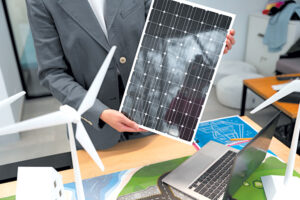More than fifteen years ago now, Republic Act No. 9513 — otherwise known as the Renewable Energy Act of 2008 — paved the way towards a vision of a Philippines with an equitable and inclusive prosperity powered by its abundant sustainable energy resources. Shortly before that landmark piece of legislation was passed, in a different part of the world, Apple unveiled the first ever iPhone, changing the world and the way we interact with it forever.
Since that time, smartphones and digital technology has accelerated to what seemingly is lightspeed. Today, the newest phones are as powerful as a mid-range desktop computer and are even equipped with capabilities like artificial intelligence.
Similarly, clean energy technology has grown by leaps and bounds in that timespan. According to the International Energy Agency (IEA), in 2023 global clean energy deployment reached new heights, with annual additions of solar PV (photovoltaic) and wind growing 85% and 60% respectively, and capacity additions for these two technologies reaching almost 540 gigawatts (GW).
Electric car sales grew around 35% in 2023, reaching 14 million vehicles or one-in-five sales globally. Majority of these sales were led again by China, wherein one-in-three cars sold was electric. In the European Union, this figure was one-in-four.
And yet, as proliferous as smartphones are today as compared to 2008, clean energy technologies unfortunately remain concentrated in advanced economies and China, with the rest of the world continuing to lag well behind.
“In 2023, China and advanced economies accounted for 90% of capacity additions for wind and solar PV, and more than 95% of global sales of electric cars,” the IEA wrote in its Clean Energy Market Monitor for March 2024.
The IEA considers the deployment of five clean energy technologies — solar PV, wind power, nuclear power, electric cars, and heat pumps — to be the key towards avoiding annual fossil fuel energy demand. From 2019 to 2023, these technologies helped countries around the world avoid around 25 exajoules (EJ) of fossil fuel energy.
“This is equivalent to 5% of total global fossil fuel demand in all sectors in 2023, or almost the combined total energy demand of Japan and Korea from all sources last year,” the IEA noted.
Not all of the technologies are receiving attention, however. Heat pump sales have declined globally from the record levels of 2022, “as squeezed consumers avoided spending on big ticket items and concerns around high gas prices eased somewhat. The slowdown of heat pump sales highlights the importance of supportive policies to help cash-strapped consumers and reduce the gap between electricity and gas prices.”
Meanwhile, nuclear capacity additions dropped to 5.5 GW in 2023, though this is less meaningful due to the technology’s long project development and execution timelines. Just five new nuclear reactor projects began construction in 2023. The IEA noted that world’s reactor construction count was at 58 units, with a combined capacity of more over 60 GW, as of the beginning of 2024.
Interest in hydrogen electrolysers — which are essential for producing low-emission hydrogen and can play a key role in decarbonizing hard-to-abate sectors like heavy industry and transportation — is growing, as demand for them grew by 360% in 2023 from a very low base.
“This increase was due largely to China, as the European Union ceded its leading position. The United States also increased the speed of deployment, but annual additions remained modest in absolute terms,” the IEA wrote.
“Energy efficiency is lagging behind, however. Our latest assessment shows an energy intensity improvement of around 1% in 2023, four times lower than the COP28 pledge to double the long-run rate of energy intensity improvement by 2030,” the agency further explained.
IEA’s report further noted that the deployment of the five key technologies: solar PV, wind power, nuclear power, electric cars, and heat pumps from 2019 to 2023 avoids around 2.2 billion tonnes (Gt) of emissions annually. “Without them, the increase in CO2 (carbon dioxide) emissions globally over the same period would have been more than three times larger,” it added.
Globally, the deployment of solar PV over the past five years has cut around 1.1 Gt of emissions annually, which is roughly equivalent to the annual emissions of Japan’s entire energy sector. In markets like Australia and New Zealand, the impact is even more pronounced, with solar PV reducing CO2 emissions by nearly 10% of the region’s total energy-related emissions in 2023.
Wind power has avoided about 830 metric tons (Mt) of CO2 emissions annually, while nuclear energy has prevented 160 Mt of CO2. Electric cars and heat pumps have avoided 60 Mt and 50 Mt of CO2 emissions respectively. Though the reductions from electric cars and heat pumps are currently smaller compared to other technologies, they are expected to grow as the stock of these technologies expands, increasing their share in new sales and the overall equipment in use.
Overall, the trend is positive. IEA Executive Director Fatih Birol said in a separate report that, “For every dollar going to fossil fuels today, almost two dollars are invested in clean energy.”
“The rise in clean energy spending is underpinned by strong economics, continued cost reductions and by considerations of energy security,” he added.
The IEA found that global investment in the manufacturing of the five key clean energy technologies rose to USD 200 billion in 2023, an increase of more than 70% from 2022 that accounted for around 4% of global GDP growth. And it is expected to rise even further.
The organization expects global investment in clean energy technology and infrastructure to reach $2 trillion this year. This is twice the amount that is going into fossil fuels, with total energy investments expected to exceed $3 trillion for the first time in 2024.
Around $2 trillion is earmarked for clean technologies — including renewables, electric vehicles, nuclear power, grids, storage, low-emissions fuels, efficiency improvements and heat pumps — with the rest directed towards gas, oil and coal. The total investment in renewables overtook the amount spent on fossil fuels for the first time in 2023.
“Clean energy investment is setting new records even in challenging economic conditions, highlighting the momentum behind the new global energy economy,” Mr. Birol said. “But there is a strong element of industrial policy, too, as major economies compete for advantage in new clean energy supply chains.”
“More must be done to ensure that investment reaches the places where it is needed most, in particular the developing economies where access to affordable, sustainable and secure energy is severely lacking today.” — Bjorn Biel M. Beltran





